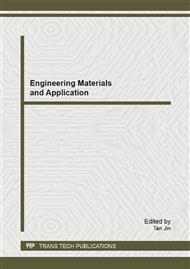p.42
p.49
p.54
p.60
p.67
p.73
p.77
p.83
p.87
Carboxymethylation Fiber of Dissolved Air Flotation Rejects and its Influences on Paper Properties
Abstract:
Fibers of dissolved air flotation rejects were been carboxymethylated to make dry strengthening agent. The effects of carboxymethylated time on carboxyl content, water retention value and physical properties of paper sheets were discussed. The effects of pH, dose of additive agent and additive aluminum sulfate on paper properties were discussed. The result show that carboxyl content and water retention values increased with the increasing of carboxymethylated time according to the research. IR analysis indicates that carboxymethyl has been connected to the surface of fibers. SEM micrographs shown that fibers were intergraded more closely benefit from the addition of dry strengthening agent. Tensile index, burst index and folding endurance respectively increased by 90.1% 101.8% and 833.3% on the condition: the additive agent amount 3%, pH 5, additive aluminum sulfate 0.5% of original pulp. Tensile index, burst index and folding endurance respectively increased by 74.0%, 87.8% and 877.8% when the carboxymethylated time was 110min for recycled pulp. This paper can be used as the theoretical basis for reusing of fiber of dissolved air flotation rejects.
Info:
Periodical:
Pages:
67-72
Citation:
Online since:
January 2013
Authors:
Price:
Сopyright:
© 2013 Trans Tech Publications Ltd. All Rights Reserved
Share:
Citation:


